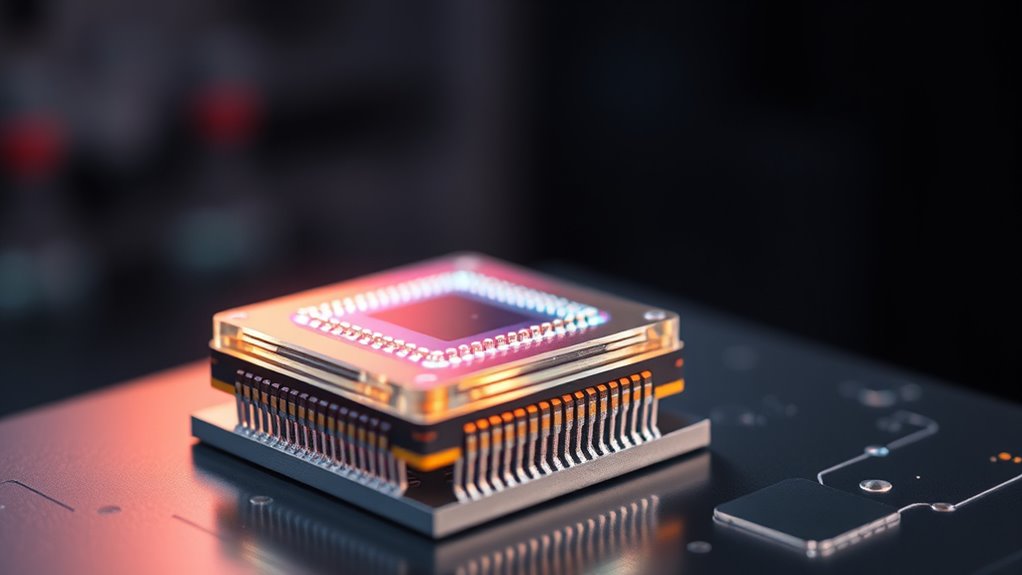Graphene transistors have broken the 1 THz barrier, opening doors for ultra-fast electronics. Thanks to graphene’s high electron mobility, minimal resistance, and efficient quantum tunneling, these devices can operate at unprecedented speeds. This advancement promises revolutionary improvements in communication, sensors, and high-frequency applications. If you want to discover how these transistors are changing the future of technology, there’s much more to explore below.
Key Takeaways
- Graphene’s high electron mobility and minimal resistance enable transistors to operate efficiently beyond 1 THz frequencies.
- Advanced fabrication techniques improve material quality, reducing quantum tunneling effects that limit high-frequency performance.
- Quantum tunneling and interface control are managed to minimize delays, allowing graphene transistors to surpass the 1 THz threshold.
- Achieving this milestone paves the way for ultra-fast communication, high-frequency sensors, and next-generation electronics.
- Overcoming manufacturing and stability challenges ensures scalable production of reliable graphene transistors for commercial use.
The Science Behind Graphene Transistor Speed

Graphene transistors achieve remarkable speeds primarily because of graphene’s unique electronic properties. Its electrons move at high velocities due to minimal resistance, enabling rapid switching. Quantum tunneling plays a crucial role by allowing electrons to pass through potential barriers efficiently, boosting speed beyond traditional limits. This phenomenon reduces delays caused by energy barriers, making high-frequency operation possible. Additionally, thermal management is vital; graphene’s excellent heat conduction helps dissipate heat quickly, preventing overheating during high-speed switching. This efficient thermal regulation maintains transistor performance and reliability at terahertz frequencies. Moreover, understanding beneficial design strategies is essential for optimizing device performance and ensuring stable operation at ultra-high speeds.
Techniques Used to Achieve the 1 THz Milestone

To reach the 1 THz milestone, researchers employ a combination of advanced fabrication techniques and innovative device architectures. They optimize graphene transistors to minimize quantum tunneling effects that can hinder performance at high frequencies. Precise control over material quality and interfaces reduces unwanted tunneling currents, ensuring signal integrity. Additionally, effective thermal management is critical; high-frequency operation generates heat, so integrating efficient heat dissipation structures prevents overheating and maintains stability. Researchers also use nanoscale patterning and contact engineering to enhance electron mobility, boosting speed. These techniques work together to push graphene transistors beyond previous limits, allowing them to operate efficiently at terahertz frequencies while maintaining reliability and performance. Material quality control is essential to ensure consistent device performance at these high frequencies.
Implications for Future High-Frequency Technologies

How will breaking the 1 THz barrier transform future high-frequency technologies? This breakthrough opens doors to faster communication systems, advanced sensors, and more powerful computing. Graphene transistors enable signals to travel with minimal delay, pushing the limits of current electronics. However, as frequencies increase, quantum tunneling becomes more significant, potentially impacting device stability and performance. Effective thermal management also becomes critical, as higher speeds generate more heat, risking device failure. Your designs will need to address these challenges to fully harness graphene’s potential. The ability to operate reliably at these frequencies could revolutionize industries like telecommunications, radar, and quantum computing, making devices faster, more efficient, and more compact. Overall, this milestone paves the way for a new era of high-frequency technology development. Additionally, addressing AI security concerns related to these advanced devices will be essential to ensure safe and reliable deployment at scale.
Challenges Remaining in Graphene Transistor Development

While graphene transistors have made significant strides, several hurdles still need addressing. You’ll need better material quality, scalable manufacturing methods, and solutions for device stability. Overcoming these challenges is essential to fully realize graphene’s potential in high-frequency applications. Additionally, innovative design techniques can further optimize transistor performance and reliability.
Material Quality Improvements
Despite significant progress, achieving consistently high-quality graphene materials remains a key challenge in transistor development. You need to focus on defect control to minimize imperfections that can impair electronic performance. Even small defects can cause scattering, reducing carrier mobility and limiting speed. Layer uniformity is equally critical; uneven or multilayer regions can disrupt the material’s exceptional properties. Ensuring a consistent, monolayer structure across large areas is essential for reliable device operation at high frequencies. While fabrication methods have improved, controlling defect density and maintaining uniformity remain hurdles. These material quality issues directly impact transistor performance, especially at the THz scale. To push forward, you must refine synthesis techniques, optimize growth conditions, and develop in-situ monitoring for better defect management and layer consistency. Additionally, implementing advanced characterization methods can help identify and address material imperfections more effectively.
Manufacturing Scalability Challenges
Scaling up graphene transistor production presents significant manufacturing challenges that must be addressed to realize commercial viability. The primary hurdles involve scalability hurdles and fabrication complexities that hinder mass production. You face difficulties in maintaining consistent quality while increasing output, risking variability that impacts performance. To illustrate these challenges, consider the following:
| Challenge | Impact | Solution Focus |
|---|---|---|
| Scalability hurdles | Limits large-scale deployment | Process automation |
| Fabrication complexities | Increases defects and yields | Advanced fabrication |
| Material uniformity | Affects transistor reliability | Quality control |
| Cost of production | Limits market adoption | Cost reduction tactics |
| Integration issues | Hinders device integration | Standardization |
Overcoming these obstacles requires innovative manufacturing strategies to ensure graphene transistors reach their full potential. Color accuracy and other factors significantly influence the performance and reliability of these devices.
Device Stability Issues
Achieving long-term performance stability remains a key challenge in developing graphene transistors. Thermal management is critical, as excessive heat can degrade device performance and cause failure over time. Ensuring effective heat dissipation helps maintain the transistor’s high-speed capabilities and prevents reliability issues. You need to address material imperfections and interface stability, which can impact long-term reliability. Fluctuations in temperature or electrical stress may lead to device degradation, making consistent operation difficult. Developing robust cooling solutions and improving fabrication processes are essential steps to enhance stability. Without these measures, the promise of graphene transistors for high-frequency applications could be compromised by reliability concerns, limiting their commercial viability and widespread adoption. Material integrity also plays a vital role in maintaining device performance over extended periods.
Comparing Graphene and Traditional Silicon Transistors

You’ll notice that graphene transistors can operate at much higher speeds and frequencies than traditional silicon ones. This is mainly due to graphene’s superior electrical conductivity, which allows electrons to move more freely. However, manufacturing graphene transistors faces unique challenges, making their production more complex than silicon-based devices.
Speed and Frequency
Graphene transistors outperform traditional silicon devices in both speed and frequency, pushing the limits of current electronic technology. Thanks to their high electron mobility, electrons move faster through graphene, enabling quicker signal processing. Unlike silicon, graphene’s two-dimensional structure reduces quantum tunneling effects that can slow down transistors at high speeds, allowing for more stable operation at terahertz frequencies. This means you can expect faster data transfer rates and improved performance in high-frequency applications. The ability of graphene transistors to operate efficiently at these frequencies surpasses that of silicon, making them ideal for next-generation communication and computing devices. Additionally, material properties of graphene contribute to its exceptional performance, enabling it to operate at these high frequencies with greater stability. As a result, graphene’s superior speed and frequency capabilities are paving the way for more powerful, faster electronics.
Material Conductivity Differences
While silicon has been the standard material for transistors due to its good conductivity and abundant availability, graphene exhibits markedly higher electrical conductivity thanks to its unique two-dimensional structure. Unlike silicon, graphene’s electrons experience minimal scattering, resulting in exceptionally high electron mobility. This means electrons can move faster through the material, enabling higher frequency performance. Additionally, quantum effects in graphene are less disruptive at high speeds, maintaining conductivity even at terahertz frequencies. Silicon’s conductivity relies on doping and complex structures, whereas graphene’s intrinsic properties allow for more efficient charge transport. As a result, graphene’s material conductivity surpasses silicon’s, making it a promising candidate for ultra-fast transistors capable of breaking the 1 THz barrier.
Manufacturing Challenges
Despite its remarkable electrical properties, manufacturing graphene transistors presents significant challenges compared to traditional silicon devices. Producing high-quality graphene at scale remains costly, hindering cost reduction efforts. Unlike silicon, graphene requires precise techniques like chemical vapor deposition, complicating mass production. Additionally, handling graphene involves environmental concerns due to chemical processes and waste management. Developing effective creative problem-solving strategies is essential to overcome these manufacturing hurdles efficiently.
Potential Industries Transformed by Ultra-Fast Transistors

The advent of ultra-fast transistors capable of surpassing 1 THz opens up transformative possibilities across multiple industries. In communications, these transistors enable faster data transmission, improving internet speeds and supporting quantum effects for secure communications. In electronics, they lead to more energy-efficient devices by reducing power consumption, which is vital for portable and large-scale systems. The semiconductor industry benefits from increased processing speeds, allowing for advanced computing and AI applications. Additionally, industries like aerospace and defense can leverage these transistors for high-frequency radar and sensing systems. Overall, their ability to operate at higher frequencies while maintaining energy efficiency paves the way for innovations that can reshape technology, enhance performance, and reduce environmental impact across various sectors. Understanding transistor limitations can further optimize their application and integration.
Frequently Asked Questions
What Are the Environmental Impacts of Manufacturing Graphene Transistors?
When you consider the environmental impacts of manufacturing graphene transistors, you should think about their environmental footprint and recycling challenges. Producing graphene involves energy-intensive processes, which can increase carbon emissions. Additionally, recycling these transistors can be difficult due to their complex materials, potentially leading to electronic waste. You need to assess these factors to guarantee sustainable development and minimize ecological harm while advancing transistor technology.
How Does Temperature Affect Graphene Transistor Performance at High Frequencies?
You might notice that temperature plays a big role in graphene transistor performance at high frequencies. As temperature rises, thermal stability can decrease, causing potential device failure. Higher temperatures also reduce carrier mobility, which slows down electron flow and impacts switching speeds. To keep these transistors functioning efficiently at high frequencies, managing temperature is key, ensuring thermal stability and maintaining high carrier mobility for peak performance.
Are There Cost-Effective Methods for Mass-Producing Graphene Transistors?
Oh, sure, mass-producing graphene transistors cost-effectively is as easy as herding cats, right? Well, tackling scaling challenges and ensuring material purity are key. You can explore chemical vapor deposition or roll-to-roll processes, but watch out for quality hiccups. These methods aim to cut costs without sacrificing performance, even if it feels like chasing a unicorn. So, yes, progress is happening, but it’s not exactly a walk in the park.
What Are the Longevity and Reliability Concerns for Graphene-Based Devices?
You should consider that longevity and reliability concerns for graphene-based devices involve device degradation and material stability. Over time, exposure to environmental factors can cause material instability, leading to device degradation and performance loss. While graphene’s remarkable properties suggest high durability, you need to monitor for potential issues like material fatigue or contamination that could impact long-term reliability. Ensuring proper encapsulation and protective measures helps mitigate these concerns.
How Do Graphene Transistors Compare to Emerging 2D Material Transistors?
Imagine a race where graphene transistors zoom ahead, thanks to their exceptional electronic properties like high mobility and speed. Compared to emerging 2D material transistors, graphene excels in speed and material integration, making it ideal for ultra-fast electronics. However, other 2D materials, like transition metal dichalcogenides, offer better tunability and potential for specific applications. You’d choose based on your needs—speed versus customization and stability.
Conclusion
You’ve seen how graphene’s groundbreaking growth pushes past the 1 THz threshold, transforming tech with tantalizing speed. As advancements accelerate, remember that persistent patience and persistent progress propel progress. By embracing the breakthroughs and battling the barriers, you can be part of a future where faster, finer, and freer electronics fuel fierce innovation. Stay inspired, stay informed — because in this fast-moving field, your involvement ignites incredible innovations.










